Genome-wide identification and expression analysis of the bZIP transcription factor family genes in response to abiotic stress in Nicotiana tabacum L
- PMID: 35448973
- PMCID: PMC9027840
- DOI: 10.1186/s12864-022-08547-z
Genome-wide identification and expression analysis of the bZIP transcription factor family genes in response to abiotic stress in Nicotiana tabacum L
Abstract
Background: The basic leucine zipper (bZIP) transcription factor (TF) is one of the largest families of transcription factors (TFs). It is widely distributed and highly conserved in animals, plants, and microorganisms. Previous studies have shown that the bZIP TF family is involved in plant growth, development, and stress responses. The bZIP family has been studied in many plants; however, there is little research on the bZIP gene family in tobacco.
Results: In this study, 77 bZIPs were identified in tobacco and named NtbZIP01 through to NtbZIP77. These 77 genes were then divided into eleven subfamilies according to their homology with Arabidopsis thaliana. NtbZIPs were unevenly distributed across twenty-two tobacco chromosomes, and we found sixteen pairs of segmental duplication. We further studied the collinearity between these genes and related genes of six other species. Quantitative real-time polymerase chain reaction analysis identified that expression patterns of bZIPs differed, including in different organs and under various abiotic stresses. NtbZIP49 might be important in the development of flowers and fruits; NtbZIP18 might be an important regulator in abiotic stress.
Conclusions: In this study, the structures and functions of the bZIP family in tobacco were systematically explored. Many bZIPs may play vital roles in the regulation of organ development, growth, and responses to abiotic stresses. This research has great significance for the functional characterisation of the tobacco bZIP family and our understanding of the bZIP family in higher plants.
Keywords: Abiotic stress; Gene expression patterns; Nicotiana tabacum L.; bZIP family.
© 2022. The Author(s).
Conflict of interest statement
The authors declare that they have no competing interests.
Figures
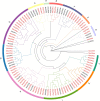
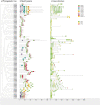

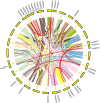
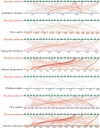
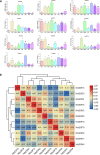
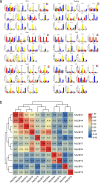
Similar articles
-
Genome-wide identification and characterization of bZIP transcription factors and their expression profile under abiotic stresses in Chinese pear (Pyrus bretschneideri).BMC Plant Biol. 2021 Sep 9;21(1):413. doi: 10.1186/s12870-021-03191-3. BMC Plant Biol. 2021. PMID: 34503442 Free PMC article.
-
In silico analysis identified bZIP transcription factors genes responsive to abiotic stress in Alfalfa (Medicago sativa L.).BMC Genomics. 2024 May 21;25(1):497. doi: 10.1186/s12864-024-10277-3. BMC Genomics. 2024. PMID: 38773372 Free PMC article.
-
Identification and characterization of the bZIP transcription factor family and its expression in response to abiotic stresses in sesame.PLoS One. 2018 Jul 16;13(7):e0200850. doi: 10.1371/journal.pone.0200850. eCollection 2018. PLoS One. 2018. PMID: 30011333 Free PMC article.
-
Basic leucine zipper domain transcription factors: the vanguards in plant immunity.Biotechnol Lett. 2017 Dec;39(12):1779-1791. doi: 10.1007/s10529-017-2431-1. Epub 2017 Sep 6. Biotechnol Lett. 2017. PMID: 28879532 Review.
-
Role of bZIP transcription factors in the regulation of plant secondary metabolism.Planta. 2023 Jun 10;258(1):13. doi: 10.1007/s00425-023-04174-4. Planta. 2023. PMID: 37300575 Review.
Cited by
-
An Investigation into the Evolutionary Characteristics and Expression Patterns of the Basic Leucine Zipper Gene Family in the Endangered Species Phoebe bournei Under Abiotic Stress Through Bioinformatics.Plants (Basel). 2025 Jul 25;14(15):2292. doi: 10.3390/plants14152292. Plants (Basel). 2025. PMID: 40805641 Free PMC article.
-
A Genome-Wide Analysis of StTGA Genes Reveals the Critical Role in Enhanced Bacterial Wilt Tolerance in Potato During Ralstonia solanacearum Infection.Front Genet. 2022 Jul 26;13:894844. doi: 10.3389/fgene.2022.894844. eCollection 2022. Front Genet. 2022. PMID: 35957683 Free PMC article.
-
Genome-wide identification and characterization of the bZIP gene family and their function in starch accumulation in Chinese chestnut (Castanea mollissima Blume).Front Plant Sci. 2023 Apr 3;14:1166717. doi: 10.3389/fpls.2023.1166717. eCollection 2023. Front Plant Sci. 2023. PMID: 37077628 Free PMC article.
-
In-Depth Characterization of bZIP Genes in the Context of Endoplasmic Reticulum (ER) Stress in Brassica campestris ssp. chinensis.Plants (Basel). 2024 Apr 22;13(8):1160. doi: 10.3390/plants13081160. Plants (Basel). 2024. PMID: 38674568 Free PMC article.
-
Genome-wide identification of bZIP transcription factors and their expression analysis in Platycodon grandiflorus under abiotic stress.Front Plant Sci. 2024 May 28;15:1403220. doi: 10.3389/fpls.2024.1403220. eCollection 2024. Front Plant Sci. 2024. PMID: 38863542 Free PMC article.
References
-
- Rodriguez-Uribe L, O’Connell MA. A root-specific bZIP transcription factor is responsive to water deficit stress in tepary bean (Phaseolus acutifolius) and common bean (P. vulgaris). J Exp Bot. 2006;57:1391-8. 10.1093/jxb/erj118. - PubMed
-
- Zhang Lina. Functional study of wheat transcription factors bZIP and NAC Genes involved in Abiotic stress tolerance. Chinese Academy of Agricultural Sciences. 2014.
MeSH terms
Substances
Grants and funding
LinkOut - more resources
Full Text Sources
Miscellaneous

